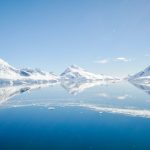 November 1, 2021 4:57 pm
Published by Jenny Rislund
November 1, 2021 4:57 pm
Published by Jenny Rislund
The Weddell Gyre, located east of the Antarctic Peninsula, is one of the largest features of the ocean circulation of the Southern Hemisphere. A deeper understanding of the dynamics in this remote region will shed light on the role of the gyre in our present climate and help us understand its potential evolution with climate change.
 August 18, 2021 9:29 am
Published by Jenny Rislund
August 18, 2021 9:29 am
Published by Jenny Rislund
Dimethyl sulfide (DMS) is a biogenic source of sulfate aerosol that influences the climate system by reducing solar radiation and altering cloud properties. Recent observations suggest that DMS may play a dominant role in the aerosol and cloud formation along the Antarctic coast where DMS is produced by marine microbes that reside on top, in, and under sea ice. However, the role of DMS remains unclear especially over the regional scale, partly due to the lack of compilation of DMS data.
 April 14, 2021 10:39 am
Published by Climate Extremes
April 14, 2021 10:39 am
Published by Climate Extremes
Welcome to the first Weather and Climate Interactions RP report. The new program name is simply a result of rationalising CLEX’s continuing research program under new headings that more clearly delineate the focus of the work we do.
 December 14, 2020 11:45 am
Published by Climate Extremes
December 14, 2020 11:45 am
Published by Climate Extremes
It has been remarkable how much we have achieved in this extraordinarily difficult year. Research coming out of the Teleconnections and Variability program over the past four months has strongly focused on how influences in one part of the world can have direct impacts on another.
 November 24, 2020 3:11 pm
Published by Climate Extremes
November 24, 2020 3:11 pm
Published by Climate Extremes
This study is based the well-established fact that sea ice cover is very closely related to surface air temperature, so that we can use trends in Antarctic sea ice as an independent validation for the reanalysis trends.
 August 6, 2020 3:47 pm
Published by Jenny Rislund
August 6, 2020 3:47 pm
Published by Jenny Rislund
In this project you will investigate the competing effects the Antarctic ozone hole and increasing greenhouse gases have on the Australian summer season rainfall, using the latest climate models. These are now available on the National Computing Infrastructure (NCI) supercomputer and are being used as input into the Intergovernmental Panel on Climate Change’s Sixth Assessment Report.
 August 6, 2020 1:17 pm
Published by Jenny Rislund
August 6, 2020 1:17 pm
Published by Jenny Rislund
This project investigates access pathways of the relatively warm water to the continental shelf by analysing output from a coupled ocean – sea ice model. The student will gain experience in polar oceanography and in the analysis and visualisation of large numerical datasets using python.
 June 30, 2020 10:46 am
Published by Climate Extremes
June 30, 2020 10:46 am
Published by Climate Extremes
CLEX researchers found the influence of climate change and the depletion in stratospheric ozone are the major drivers over the Atlantic Oceans that shift westerly winds further south. However, over the Pacific and Indian oceans natural variations induced by sea surface temperature changes in the tropical Pacific also play an important role.
 May 2, 2020 4:00 am
Published by Climate Extremes
May 2, 2020 4:00 am
Published by Climate Extremes
Using a high-resolution ocean model, CLEX researchers unexpectedly found 80% of the transport in the warm water layer, known as Circumpolar Deep Water, approaches Antarctica in the colder regions.
 September 3, 2019 11:06 am
Published by Climate Extremes
September 3, 2019 11:06 am
Published by Climate Extremes
CLEX researchers and colleagues examined the movement of surface water into the depths of the ocean in response to these wind changes using a global ocean model.










